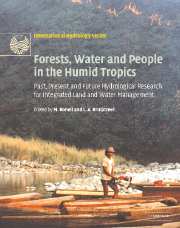 Forests, Water and People in the Humid Tropics
Forests, Water and People in the Humid Tropics from Part IV - New methods for evaluating effects of land-use change
Published online by Cambridge University Press: 12 January 2010
INTRODUCTION
Models are used increasingly to simulate hydrological processes within tropical regions. There is now a wealth of publications addressing evaporation modelling (particularly wet-canopy evaporation) of local areas of tropical forest in, for example, Niger (Gash et al., 1997), Guyana (Jetten, 1996), Puerto Rico (Schellekens et al., 1999), Columbia (Marin et al., 2000) and Indonesia (Asdak et al., 1999; van Dijk and Bruijnzeel, 2001). Elsewhere in this volume, Roberts et al. provide an overview of evaporation processes and modelling. Other modelling studies have addressed the impact of such tropical evaporation on regional climates and global circulation (e.g. Polcher and Laval, 1994; Zeng, 1999; Zeng and Neelin, 1999; Zheng et al., 2001). New studies using time-series models are highlighting the effects of cycles in the rainfall, such as the El Niño Southern Oscillation (ENSO) on tropical evaporation, riverflow and water quality (e.g. Zeng, 1999; Chappell et al., 2001; Krishnaswamy et al., 2001; Whitaker et al., 2001; Chappell, Tych et al., this volume). Similarly, models that simulate the generation of riverflow from the rainfall received by a tropical catchment are also beginning to be applied more frequently. These models include:
Metric-conceptual models of waterflow, based upon transfer functions. For example, application of the DBM modelling approach to a nested catchment system in Malaysian Borneo (Chappell et al., 1999a) and the application of IHACRES to a large Thai basin (Scoccimarro et al., 1999).
Conceptual models of waterflow based upon stores and pre-determined empirical relationships. For example, application of the Nash model to Kenyan catchments (Onyando and Sharma, 1995), the Modhydrolog model to a tropical catchment (Chiew et al., 1996), the Reservoir-Water-Balance-Simulation model to Namibian catchments (Hughes and Metzler, 1998), and the HBV-96 model (discussed in Barnes and Bonell, this volume) to catchments in Zimbabwe, Tanzania and Bolivia (Liden and Harlin, 2000).
[…]
To save this book to your Kindle, first ensure no-reply@cambridge.org is added to your Approved Personal Document E-mail List under your Personal Document Settings on the Manage Your Content and Devices page of your Amazon account. Then enter the ‘name’ part of your Kindle email address below. Find out more about saving to your Kindle.
Note you can select to save to either the @free.kindle.com or @kindle.com variations. ‘@free.kindle.com’ emails are free but can only be saved to your device when it is connected to wi-fi. ‘@kindle.com’ emails can be delivered even when you are not connected to wi-fi, but note that service fees apply.
Find out more about the Kindle Personal Document Service.
To save content items to your account, please confirm that you agree to abide by our usage policies. If this is the first time you use this feature, you will be asked to authorise Cambridge Core to connect with your account. Find out more about saving content to Dropbox.
To save content items to your account, please confirm that you agree to abide by our usage policies. If this is the first time you use this feature, you will be asked to authorise Cambridge Core to connect with your account. Find out more about saving content to Google Drive.